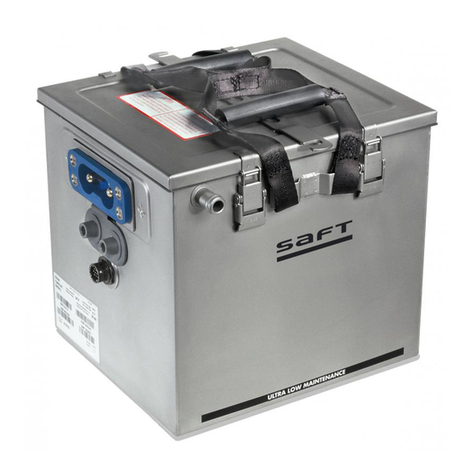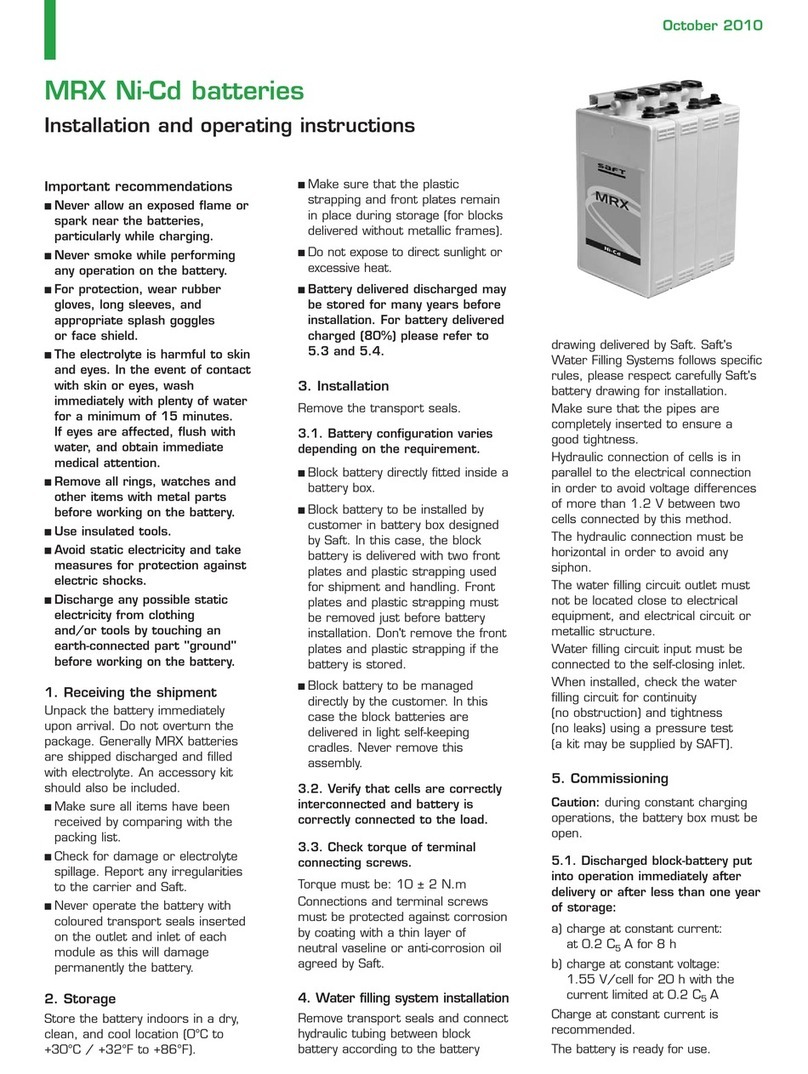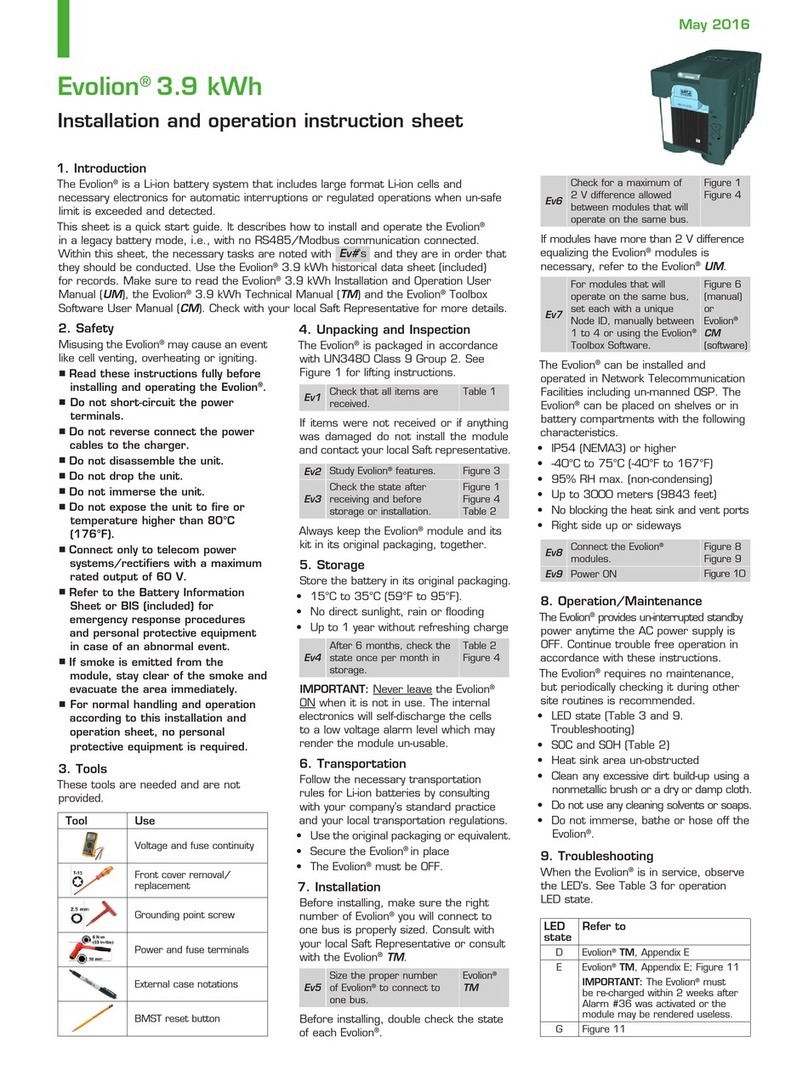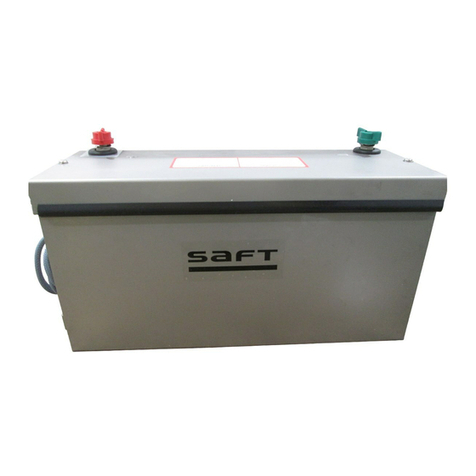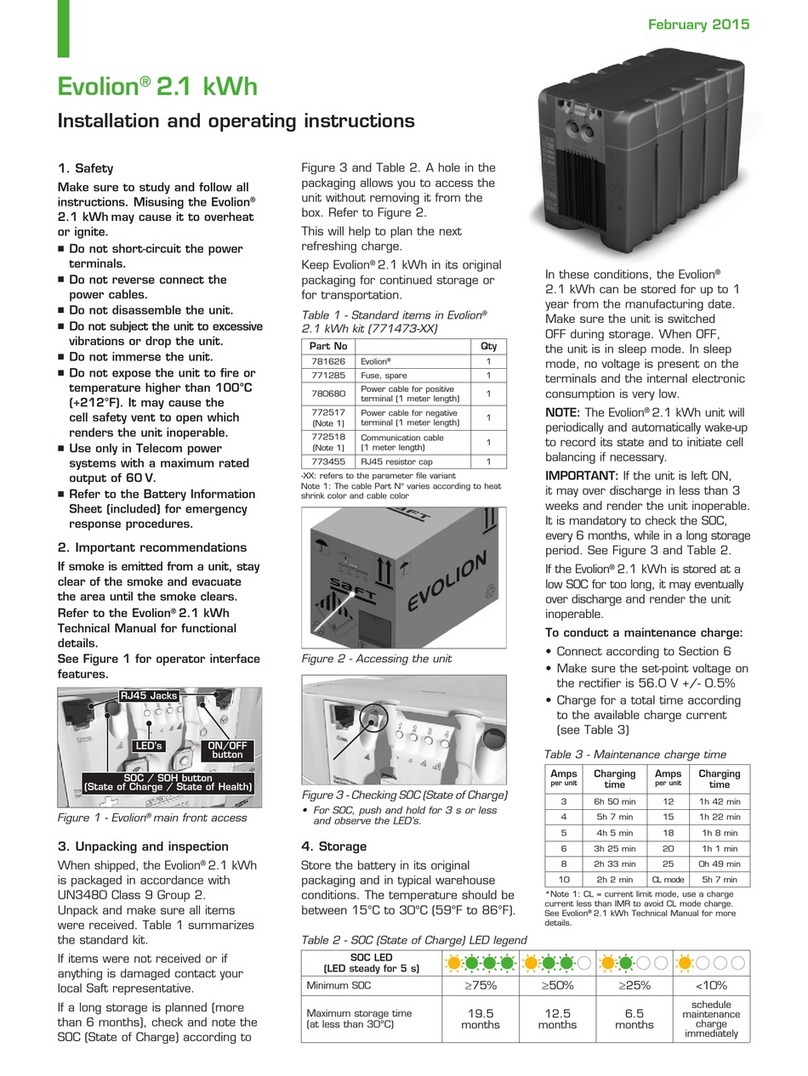Saft SRX 720 User manual

Important recommendations
■Never allow an exposed flame or
spark near the batteries,
particularly while charging.
■Never smoke while performing any
operation on the battery.
■For protection, wear rubber gloves,
long sleeves, and appropriate
splash goggles or face shield.
■The electrolyte is harmful to skin
and eyes. In the event of contact
with skin or eyes, wash immediately
with plenty of water. If eyes are
affected, flush with water, and
obtain immediate medical attention.
■Remove all rings, watches and
other items with metal parts before
working on the battery.
■Use insulated tools.
■Avoid static electricity and take
measures for protection against
electric shocks.
■Discharge any possible static
electricity from clothing
and/or tools by touching an
earth-connected part "ground"
before working on the battery.
1. Receiving the shipment
Unpack the battery immediately upon
arrival. Do not overturn the package.
Transport seals are located under the
cover of the vent plug.
The battery is normally shipped filled
and ready for installation. Remove
the plastic transport seals. The battery
is then ready for installation.
The battery must never be used
electrically with the plastic transport
seal in place as this can cause
permanent damage.
2. Storage
Store the battery indoors in a dry,
clean, cool location (0°C to +30°C /
+32°F to +86°F).
■Make sure that the transport seals
remain in place during storage.
■Do not store in direct sunlight or
exposed to excessive heat.
■A battery delivered discharged and
filled may be stored for many years
before it is installed.
■A battery delivered charged (80%)
must not be stored more than
3 months (including transport).
3. Installation
Remove the transport seals and close
the vent plugs.
3.1. Verify that cells are correctly
interconnected and that battery
SRX Ni-Cd batteries
Type plastic and steel containers
Installation and operating instructions
connection to the load is also correct.
3.2. Check tightness of terminal
connecting nuts. Torque applied
should be:
• 10 ± 2 N.m for cells SRX 22 P/FR
to 80 P/FR, SRX 50 C,
• 15 ± 2 N.m for cells SRX 900 P to
2200 P, SRX 90 FR to 220 FR,
SRX 220 F3, SRX 175 LP/LFR,
SRX 720 to 3700, SRX 90 to 250
(SRX 100 excl.), SRX 2500 P-LC,
• 30 ± 3 N.m for cells SRX 100.
The connectors and terminal nuts
should be corrosion-protected by coating
with a thin layer of neutral vaseline or
anti-corrosion oil agreed by Saft.
3.3. Electrolyte
The electrolyte to be used is E13.
Cells delivered filled:
Check the level of electrolyte. The cells
must have a level of electrolyte above
the plates. If it is not the case, adjust
the level of electrolyte to 5 mm above
the plate tops with distilled or
deionized water.
4. Commissioning
4.1. Discharged cells placed into
service immediately after delivery or
after less than one year of storage:
■Constant current charge:
• 8 h at 0.2 C5 A
Caution: during charging, the battery
box must be open.
■Constant potential charge:
• 1.55 V/cell for 20 h, with the
current limited to 0.2 C5 A
Charge at constant current is
recommended. The battery is ready
for use.
4.2. Cells stored more than 1 year:
a) charge 10 h at 0.2 C5 A
b) discharge at 0.2 C5 A down to
1.0 V/cell
c) charge 8 h at 0.2 C5 A
The battery is ready for use.
4.3. Charged cells (80%) shipped
and/or stored at temperatures
> +30°C (>+86°F), and/or ≥3 months
from date of charge:
a) charge 10 h at 0.2 C5 A
b) discharge at 0.2 C5 A down to
1.0 V/cell
c) charge 8 h at 0.2 C5 A
The battery is ready for use.
5. Charging in service
5.1. Cycling application
The battery is cycled up to 20% DOD
(Depth Of Discharge) per day.
■Single level charge:
1.45 - 1.55 V/cell, at +20°C (+68°F)
1.47 V/cell is recommended.
■Two level charge:
• High level: 1.45 - 1.60 V/cell
at +20°C (+68°F)
• Float level: 1.38 - 1.40 V/cell
at +20°C (+68°F)
5.2. Stand-by application
Battery is on float and discharged only
in emergency situation.
■Single level charge:
1.41 - 1.43 V/cell at +20°C (+68°F)
■Two level charge:
• High level: 1.43 - 1.50 V/cell
at +20°C (+68°F)
• Float level: 1.38 - 1.40 V/cell
at +20°C (+68°F)
For use at temperature outside +10°C
to +30°C (+50°F to +86°F), the charge
voltage correcting factor is:
• – 2 mV/°C/cell (–1.1 mV/°F/cell)
if charging voltage < 1.45 V/cell
at +20°C (+68°F)
• – 3 mV/°C/cell (–1.7 mV/°C/cell)
if charging voltage between 1.45 and
1.55 V/cell at +20°C (+68°F)
For higher charging voltages,
consult Saft.
To minimise the water usage,
Saft recommends the use of low
charging voltages.
6. Topping-up
■Batteries not equipped with water
filling system:
No electrolyte level measurement is
necessary if you use a Saft cell-topper,
which allows the correct level to be
obtained by a simple nozzle setting.
See nozzle lengths in Table A.
If a cell-topper is not available, the
electrolyte level must be measured.
Insert a transparent glass or plastic
tube (alkali resistant, 5 to 6 mm in
diameter) vertically into the cell vent
until it touches the top of the plates.
Close the top end of the tube by
putting a finger on it and remove it
from the cell. The height of the liquid in
the tube indicates the electrolyte level.
June 2004

Cell type: Capacity Charge current Electrolyte per cell Length of cell
In nickelled C5 Ah 0.2 C5 A Solid Liquid topper nozzle
steel container (Ah) (A) (kg) (l) (mm)
SRX 720
73 14.6 0.34 1.1 55
SRX 800
81 16.2 0.31 1.0 55
SRX 900
90 18.0 0.40 1.3 55
SRX 1000
103 20.6 0.37 1.2 55
SRX 1200
115 23.0 0.40 1.3 55
SRX 1300
130 26.0 0.46 1.5 55
SRX 1500
145 29.0 0.52 1.7 55
SRX 1700
170 34.0 0.52 1.7 55
SRX 1900
195 39.0 0.61 2.0 55
SRX 2200
220 44.0 0.73 2.4 55
SRX 2500
250 50.0 0.77 2.5 55
SRX 3000
300 60.0 0.89 2.9 55
SRX 3700
375 75.0 1.04 3.4 55
Cell type: In stainless steel container
■Topping-up operation:
Check the electrolyte level. Never let
the level fall below the minimum level
mark. Use only distilled or deionized
water to top-up.
Frequency of topping-up must be
determined for each battery.
It depends on charging voltage and
real utilization of the battery. Refer
to section 6 concerning topping-up.
8. Changing electrolyte
Due to the sintered electrode plastic
bonded technology, it is not necessary
to change the electrolyte during the life
time of the cells.
9. Environment
To protect the environment all used
batteries must be recycled.
Contact your local Saft representative
for information.
Level (mm) high low
SRX 720 to 3700 50 5
SRX 22 P/FR to 80 P/FR 55 5
SRX 900 P/90 FR to
2200 P/220 FR 55 5
SRX 175 LP/LFR 50 5
SRX 90 to 250 45 5
SRX 50 C 50 5
SRX 220 F3 44 5
SRX 2500 P-LC 70 5
■Batteries equipped with water filling
system:
• Remove transport seals and connect
hydraulic tubing between cells up to
a maximum of 50 cells.
• Make sure that the tubes are
completely inserted for a good seal.
• The hydraulic connection of cells
must be in parallel to the electrical
connection, in order to avoid
voltage differences of more than
1.2 V between two hydraulically
connected cells.
• The hydraulic connection must be
horizontal in order to avoid siphoning.
• The water filling circuit output must
not be too close to electrical
equipment, electrical circuit, and
metallic structure.
• Water filling circuit input must be
connected to the self closing inlet.
• Topping-up can be performed by
gravity or using adapted pump with a
flow rate of 0.7 l/min at a relative
pressure of 0.3 bar maximum.
7. Periodic maintenance
■Maintenance operations (not
including the topping-up operation):
Periodic maintenance should be
carried out every two years.
• Keep the battery clean using only
water. Do not use a wire brush or
solvents of any kind. Vent plugs can
be rinsed in clean water when dirty.
• Check that all connectors are tight.
Coat with grease or neutral vaseline
all terminal nuts and cell connectors.
• Check charger settings. It is of great
importance that the recommended
charging voltage remains unchanged.
High water consumption of the
battery is usually caused by improper
voltage setting of the charger.
Saft
Industrial Battery Group
12, rue Sadi Carnot
93170 Bagnolet - France
Tel: +33 1 49 93 19 18
Fax: +33 1 49 93 19 64
www.saftbatteries.com
Doc N° 21123.2 - 0604
Data in this document is subject to change without
notice and becomes contractual only after written
confirmation.
Société anonyme au capital de
31 944 000 €
RCS Bobigny B 383 703 873
Pragma - Printed in France - 2k
SRX Ni-Cd batteries
SRX 50 C
50 10.0 0.16 0.53 55
SRX 90
90 18.0 0.37 1.2 50
SRX 100
103 20.0 0.37 1.2 50
SRX 115
115 23.0 0.39 1.3 50
SRX 145
145 29.0 0.52 1.7 50
SRX 170
170 34.0 0.48 1.6 50
SRX 195
195 39.0 0.59 1.9 50
SRX 250
250 50.0 0.78 2.6 50
Cell type: In plastic container
SRX 22 P/FR
22 4.4 0.11 0.38 65
SRX 25 P/FR
25 5.0 0.10 0.35 65
SRX 31 P/FR
31 6.2 0.15 0.51 65
SRX 37 P/FR
37 7.4 0.25 0.84 65
SRX 46 P/FR
46 9.2 0.23 0.76 65
SRX 52 P/FR
52 10.4 0.21 0.70 65
SRX 60 P/FR
60 12.0 0.24 0.80 65
SRX 70 P/FR
70 14.0 0.21 0.71 65
SRX 80 P/FR
80 16.0 0.21 0.91 65
SRX 900 P/90 FR
90 18.0 0.46 1.5 55
SRX 1000 P/100 FR
103 20.6 0.43 1.4 55
SRX 1200 P/115 FR
115 23.0 0.40 1.3 55
SRX 1300 P/130 FR
130 26.0 0.46 1.5 55
SRX 1500 P/155 FR
155 31.0 0.55 1.8 55
SRX 1700 P/170 FR
170 34.0 0.67 2.2 55
SRX 1900 P/190 FR
190 38.0 0.61 2.0 55
SRX 2200 P/220 FR
220 44.0 0.73 2.4 55
SRX 175 LP/LFR
175 35.0 0.61 2.0 45
SRX 220 F3
220 44.0 0.71 2.4 45
SRX 2500 P-LC
250 50.0 0.50 1.5 50
Table A:
This manual suits for next models
40
Other Saft Camera Accessories manuals
Popular Camera Accessories manuals by other brands

Calumet
Calumet 7100 Series CK7114 operating instructions

Ropox
Ropox 4Single Series User manual and installation instructions

Cambo
Cambo Wide DS Digital Series Main operating instructions

Samsung
Samsung SHG-120 Specification sheet

Ryobi
Ryobi BPL-1820 Owner's operating manual
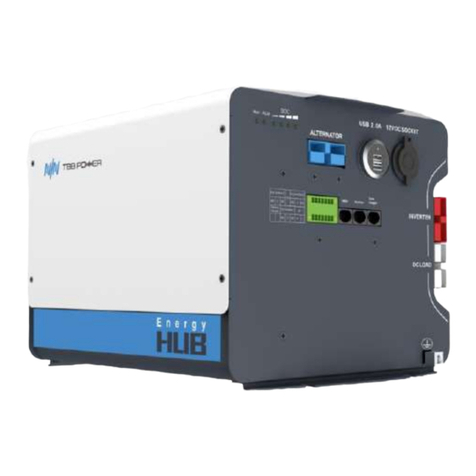
TBB power
TBB power Energy Hub EH128L user manual

